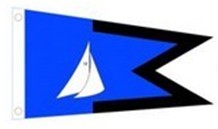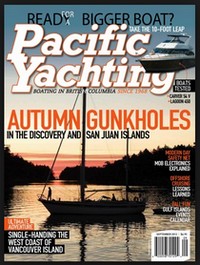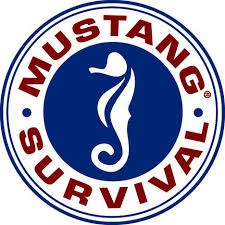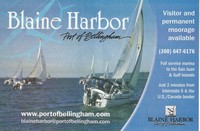MYCBC – Why Join Us › Forums › General Discussion › Getting blown all over the place at the dock.
- This topic has 0 replies, 1 voice, and was last updated 11 years, 7 months ago by
Anonymous.
-
AuthorPosts
-
December 2, 2013 at 12:08 am #1311
Anonymous
Getting blown all over the place at the dock.
Site Admin, Sat Oct 28 2006, 03:08PMNewby question posted by saynomore and moved here by sysadmin.
When sailing back to the docks, do you go in with full ballast or empty. Nigel on our first day came in empty and all was good at Vanier park. I did the same at Port moody dock and I was a gong show being blown all over, even put a few scratches on my new Saynomore. Last week I tried full ballast all went good at Vanier park except other boaters were very impatient while I was waiting for my ballast to empty.
Re: Getting blown all over the place at the dock.
Seaworthy, Sat Oct 28 2006, 03:24PMBallast is mass and as such to accelerate more mass requires more force. A boat with an empty ballast will get blown around more easily given the same wind. The extra weight hits things harder too.
When manoevering in close quarters in wind. I tend to leave the centerboard down a bit. I have an X. This is easy as the swing keel will be pushed out of the way by the trailor bunks if it is down too low. With an M, you can leave some board down until you get the bow on the bunks. Then you’ll have to remember to pull it up.
Depending on your vehicle, you should be able to clear the ramp even while the ballast empties. Classics always have to empty their ballast on the hard. Just leave the vent and port open while your getting the boat on the trailor.Re: Getting blown all over the place at the dock.
NautiMoments, Mon Oct 30 2006, 07:46AMSeaworthy is right. We have an M and thus have to ensure the dagger board is up once the boat is on the trailer. One thing we have added to our trailer is 2X6 carpeted side rails that bolt on the top of the fenders and go to around the rear guide post. We had to slot them around the guide post to get enough clearance, approx 2-3 inches extra overall. When the boat goes onto the trailer these side rails guide boat into the slot and protect it from hitting the fenders. You will find that you have about 6-10″ clearance to manover in but the bow will touch these rails and guide you in. As you pull the boat out of the water these rails will center the boat nicely on the trailer.
As I am sure you were told, always manouver near the docks with your centerboard down (ours is about 1-2 feet down) and at least one rudder down (I have both down). I usually have no ballast but in severe cross winds it can help. The Mac, with its high freeboard, is subject to windage but with a bit of practice you will master docking and trailering. I practiced at a ramp where I did not intend to return to, thus hopefully saving future embarassment. Good luck.
KenRe: Getting blown all over the place at the dock.
, Tue Mar 13 2007, 09:35PMAfter 6 years with our X I can say things will get better with time, but there will be cases where you can’t avoid getting blown around.
My personnal preference is to have the ballast empty before I return to the dock to load the boat on the trailer. That is purely for speed of loading, not for handling. Full or empty I find the boat handles the same. I do however find in a tough situation I would go empty as the boat will respond quicker both starting and stopping.
Standard config around dock is at least one rudder down and the centerboard down. If wind or current is against you consider if you can make a stern first approach. Into the wind the boat will weathervane when going bow first while you can often back it under full control. Keep both rudders down along with the centerboard.
These boats actually respond very well to spring lines. Take the time to learn and practice docking with spring lines and not only will you find the experience easy, but everyone watching will be impressed with your control of the boat.
When we were out a couple weeks ago, for one docking only my oldest son and I were on board. We had a fairly strong wind 90 degrees to the dock which made getting along side difficult. I was able to get the bow close, which is where Sam was, and being a teenager he made the big leap and got on the dock with a bowline. It wasn’t what I was planning, but we went with it. I had him cleat it with about 6′ of slack. I then reversed with the motor hard to starboard (prop toward the dock). First the boat backed until the line went tight, then the boat pivoted and stern was sucked right into the dock where I could just step out with the stern line. Simple and sweet solution to what was a tough wind situation. You can also do the same thing in forward, but I didn’t have much room in front so I chose to use reverse.
As far as loading on the trailer, we don’t use the motor at all. We always choose a launch with a dock. Tie the boat to the dock, back in the trailer, use the lines to bring the boat onto the trailer, clip on the winch and crank it home. In 6 years I have found no reason to drive the boat onto the trailer. I prefer to have the ballast empty as you don’t have to go as deep wit hthe trailer when loading, and you don’t spend the 10 minutes draining.
Re: Getting blown all over the place at the dock.
rworthy, Thu Mar 15 2007, 07:29PMI am with Alegro, I am single handed 99%of the time, always approaching with no ballast and boards down. I have few ways to approach the dock with side winds depending on winds and how busy the docks are. If it is not too windy I will approach parallel to the dock, stop the boat about two feet from the dock it and let the wind move me gently in. Three fenders are down for this. If the wind is stronger I will approach it bow first and reverse just before touching. This will stop the boat and wind will again blow the stern gently to the dock. Few times I approached the dock from the downwind side, only because I had to. I went bow first, step on the dock with the both stern and bow lines in my hand and pull it in, fighting the wind. This is tough if you are alone since the wind can turn the boat around.
In any case the name of the game is slow and all boards down. You can get them up once you are on the dock. I am yet to drive the boat on the trailer since I too always choose the ramp with the dock, That is the only way if you are single handed._/) Zoran
Re: Getting blown all over the place at the dock.
, Sun Mar 18 2007, 12:41PMZoran,
The downwind example you describe is a perfect time to use a spring line.
I assume you have a long bow line that reaches back to the cockpit and is run outside the lifelines and shrouds. Just add a large loop to the end of it at the cockpit with a bowline.
As you pull up beside the dock, rather than leaping out with both lines, just put the loop from the bow line over a dock cleat (probably the one that would normally be your stern cleat). You can even use a boat hook to get it there if you can’t get close enough.
Now with this spring line in place (lets use a dock on our starboard side in this example) power forward against it with the motor turned hard to port (thrusting starboard). Even if you have drifted back away from the dock, you wil only go forward until the line is tight then the stern of the boat will be pushed right up to the dock as you pivot arount you bow cleat. Once you are snug against the dock, leave the motor in forward at idle and get out with your stern line. The boat will hold itself tight against the dock while you get the lines secure.
It’s s simple no stress way to get the boat secure against the dock all by yourself without leaving the cockpit.
Re: Getting blown all over the place at the dock.
, Fri Sep 12 2008, 08:45AMMy experience is using an after mid-ship spring line. Use a line from a mid-ship cleat if you have one or from the chainplates. Drop the bowline in the end over a cleat near your stern and then power ahead with the outboard thrusting toward the dock. Using this method there is less chance of the bow contacting the dock and the boat will be almost parallel to the dock.
Another trick I have used many times is with the wind off the dock, the crew steps ashore with the stern line and secures it. I can then power forward with the outboard thrusting towards the dock to bring the bow close to the dock. I have not tried this on a Macgregor, however it has worked well on many power boats and sailboats.
-
AuthorPosts
- You must be logged in to reply to this topic.













